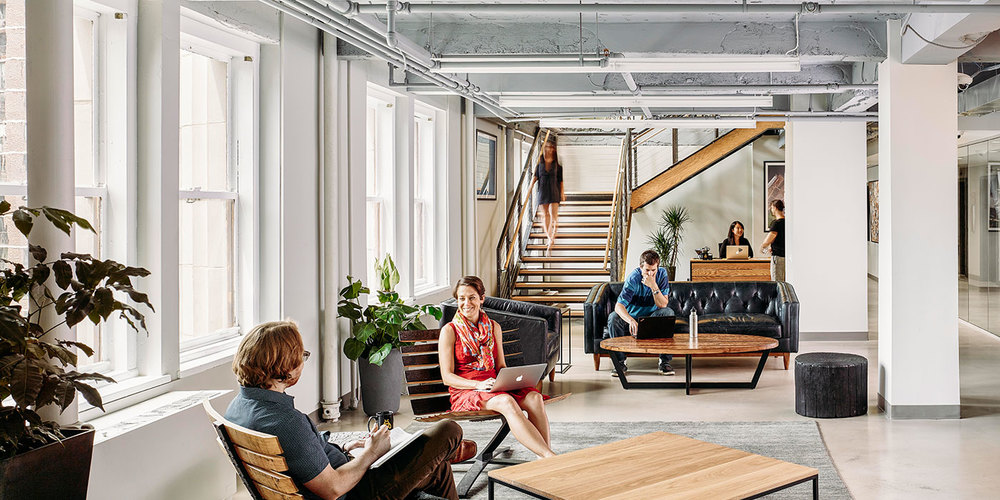There is a growing gap between technology that is available to employees at home compared to the workplace. In their latest study on the Future of the Workplace, DELL noted that:
“Employees are generally happy in their jobs, but as communications and productivity technology advances, they are becoming increasingly dissatisfied with workplace capabilities. Though they still rely on analog equipment like landlines and desktops, they’re ready for a workplace that can accommodate their changing lifestyle”
The same study noted that almost half of millennials are willing to quit their job if a company’s office technology is not up to their standards. In addition, More than 80 percent of millennials say workplace tech would have an influence when deciding to take a job.
Technology has driven personal lifestyles to evolve, changing the way we communicate and interact. Despite the huge leaps in personal technology, workplace tech is still slow to adopt changes. Workplace technology has fallen behind the home.
Adoption of Technology

Expensive technology used to be the domain of large corporations that could afford it. But, as technology improved, mass production became possible. Employees, as consumers, now have access to the latest and greatest in technology. Employees are upgrading and adopting the technology as it becomes available.
On the other hand, employers have not managed to keep up. Clunky procurement policies and slow vetting processes and procedures are common of many large offices of today. These poor equipment options often hamper the employer’s ability to provide the best technology. Alternatively, as employees desire better technology, they implement it at home. As a result, the gap between the home and work continues to widen.
Employers are responding with more bring your own devices (BYOD) policies, giving employees ability to enable their own productivity by choosing what best suits their needs. However, this solution brings with it security and risk issues.
So how do you shorten the gap between home and work when it comes to tech? Knowing where you lag behind is the first challenge:
Mobility

Workplaces have now fallen behind personal technology in terms of mobility and this is affecting productivity. BYOD programs are one way to make up for this and Tech Pro Research found that 74% of organizations are already using BYOD programs or plan to in the future. The Aberdeen Group suggests that productivity gains from better workflows are created through BYOD programs. These programs also improve employee happiness. But relying on employees to bring their own devices creates security risks.
However, many companies are still taking the risk or plan to, despite their security hesitations. This highlights the scramble happening as workplace tech tries to keep up with consumer electronics.
It’s clear handheld devices are a huge factor in workplace mobility. For any workplace, providing power to these mobile devices is also a major concern. Consumers can easily purchase lamps with wireless charging stations built in from IKEA – but a workplace solution is often hampered by slow procurement procedures.
Integration of Technology

As the smart home concept gains more traction, consumers can now control and manage many aspects of their home. They can control the whole smart home from their mobile devices. This could include security, lighting, temperature, access and more. For example, residents can control the temperature on their Nest thermostat through their phones. They can also have their home use geo-fenced information to begin to set temperatures to their preferred levels once the owner reaches a certain radius from the house.
The office however, has fallen far behind. While home automation has taken off, technology integration into the physical workspace has been slow. In the office, lack of workplace tech means employees often have to struggle through uncomfortable temperatures. Managing comfort and resources still often requires manual control and management.
Software and App Experiences

Employees can now access a full suite of services and non-business apps on their phones, tablets and personal computers. Ordering a car, room to stay, food or anything else imaginable is possible through an app on their phone. Imagine the frustration if employees can’t even book a meeting room at work without help from someone.
Many businesses believe that tech-savvy millennials will be able to solve their workplace tech problems, but this fails to address a root cause: bad software and apps. The point was recently discussed in the Telegraph, again highlighting how consumer electronic apps dominate when it comes to ease of use:
“Businesses believe throwing a horde of inexperienced millennials at the problem will solve it. But that just won’t work. Just because they are handy with Snapchat filters and emoji use doesn’t mean they can figure out decades-old software or an over-designed expenses app.”
Shortening the Gap
One of the easiest ways to address the issue is to take feedback from employees as to what type of technology they use outside the office. Further, solutions are being developed to solve problems from meeting room booking to temperature control, which can be adopted. Furniture manufacturers are also getting on board, working to align their own design cycles with the much more rapid ones of tech development.
It’s important for Facility Managers to consider these types of technological integrations in their workplace design. These integrations should be a backbone of the workplace design rather than just an add on. These functionalities are seamless elsewhere in an employee’s life and they expect the same at work.



